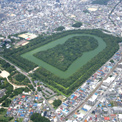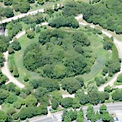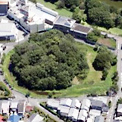Features of Mozu Kofungun
Mozu Kofungun comprises a wide variety of kofun
During the Kofun period*, more than 200,000 mounded tombs called kofun were built across the Japanese archipelago. The largest known kofun among them is the Nintoku-tenno-ryo Kofun, which is part of Mozu Kofungun. This tomb has a mound length of 486 m, and the total length including the triple surrounding moat is 840 m, making it one of the largest burial mounds in the world.
Mozu Kofungun also includes other giant keyhole kofun, which are among the largest in the country: Richu-tenno-ryo Kofun (365 m) is the third largest and Nisanzai Kofun (300 m) is the seventh largest.
Many of these giant tombs have, or once had, small- and middle-sized satellite or subsidiary tombs called baicho built around them. This is one of the unique traits of the kofun building culture, which is well-preserved in Mozu Kofungun’s rich variety of kofun shapes and sizes.
*Kofun period is a historical division of ancient Japan from the mid-3rd century to the end of the 6th century, which is characterized by the construction of large-scale kofun tombs. Kofun construction saw its peak in the 5th century.
 Keyhole-shaped kofun (Nintoku-tenno-ryo Kofun)
Keyhole-shaped kofun (Nintoku-tenno-ryo Kofun)
 Round kofun (Guwashobo Kofun)
Round kofun (Guwashobo Kofun)
 Scallop shell-shaped kofun (Maruhoyama Kofun)
Scallop shell-shaped kofun (Maruhoyama Kofun)
Mozu Kofungun can shed light on state formation in ancient Japan
The Chinese history book Book of Song records that five successive generations of powerful kings (whose names were San, Chin, Sei, Ko and Bu) appeared in ancient Japan (then called Wa) around the 5th century, and that these kings paid tributes to the Southern Dynasties of China. The king of Wa at the time was someone invested with great ruling power, a leader of a nationwide alliance of local rulers or chieftains. Mozu Kofungun (in Sakai) and Furuichi Kofungun (in Habikino and Fujiidera) are thought to be associated with the Five Kings of Wa mentioned in the Book of Song, and the both areas are thought to hold important clues as to how a centralized state took shape in ancient Japan.
Various artifacts indicating Japanese interaction with other parts of East Asia
Many grave goods have been unearthed at Mozu Kofungun, including haniwa (earthenware funerary sculptures) of varying shapes, gilt-bronze accessories, horse trappings, and iron weapons. Evident in these excavated artifacts are influences of the cultures of not only the Korean peninsula and China, but also more far-off places like Persia, indicating that Japan at the time had active interaction with other parts of East Asia.
